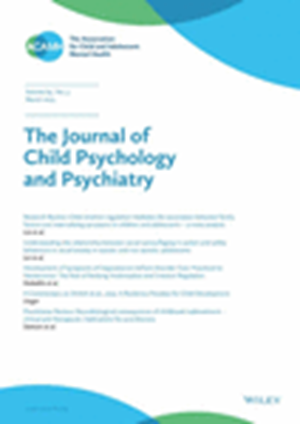在发育中的身体中发展语言:婴儿大运动行为和自我照顾/符号行为与新兴语言能力的遗传关联
IF 7
1区 医学
Q1 PSYCHIATRY
引用次数: 0
摘要
在婴儿期早期掌握大肌肉运动能力,在婴儿期后期掌握文化定义的行为(如自我照顾习惯),可以启动影响语言学习的级联发展变化。在这里,我们采用遗传学的观点来研究潜在的过程,包括共享或“门户”机制,后者使儿童能够与他们的环境互动。方法选择可遗传性状(h2,遗传力),我们研究了来自雅芳父母与儿童纵向研究(N≤7017)的基因型儿童的10种语言结果(15 - 38个月)的预测因子——婴儿大肌肉运动(6个月)和自我护理/符号(15个月)技能。使用结构方程模型(SEM)将语言测量合并为三个相互关联的语言因素(LF),对应于不同的年龄窗口(LF15M、LF24M、LF38M,总解释方差为51.3%)。采用遗传-关系-矩阵结构方程模型(GRM - SEM)作为多变量方法的一部分,通过Cholesky分解剖析了不同测量之间的发育基因组和非基因组关系。结果6个月大肌肉运动能力(h2 = 0.18 (SE = 0.06))和15个月自我护理/符号动作(h2 = 0.18 (SE = 0.06))具有中等程度的遗传性,以及三个衍生语言因子得分(LFS15M‐h2 = 0.12 (SE = 0.05), LFS24M‐h2 = 0.21 (SE = 0.06), LFS38M‐h2 = 0.17 (SE = 0.05)),可以进行遗传分析。发育遗传模型(GRM‐SEM)显示,大肌肉运动能力(6个月)与自我照顾/符号行为(15个月,因子负荷λ; λ = 0.22 (SE = 0.09))具有相同的遗传影响,但与语言表现无关(p≥0.05)。相比之下,独立于早期粗大运动技能的自我照顾/符号行为的遗传影响与所有三个语言因素(LFS15M‐λ = 0.26 (SE = 0.09), LFS24M‐λ = 0.28 (SE = 0.10), LFS38M‐λ = 0.30 (SE = 0.10))相关。研究个体语言结果的多变量模型提供了一致的结果,包括基因组和非基因组影响。结论:将幼儿大肌肉运动行为与大婴儿自我照顾/符号行为联系起来的基因编码过程与将自我照顾/符号行为与新兴语言能力联系起来的基因编码过程不同。这些发现与发展级联一致,即运动控制使儿童参与新的社会互动,但儿童的社会学习能力促进语言发展。本文章由计算机程序翻译,如有差异,请以英文原文为准。
Developing language in a developing body: genetic associations of infant gross motor behaviour and self‐care/symbolic actions with emerging language abilities
BackgroundMastering gross motor abilities in early infancy and culturally defined actions (e.g. self‐care routines) in late infancy can initiate cascading developmental changes that affect language learning. Here, we adopt a genetic perspective to investigate underlying processes, implicating either shared or “gateway” mechanisms, where the latter enable children to interact with their environment.MethodsSelecting heritable traits (h 2 , heritability), we studied infant gross motor (6 months) and self‐care/symbolic (15 months) skills as predictors of 10 language outcomes (15–38 months) in genotyped children from the Avon Longitudinal Study of Parents and Children (N ≤ 7,017). Language measures were combined into three interrelated language factors (LF) using structural equation modeling (SEM), corresponding to largely different age windows (LF15M , LF24M , LF38M , 51.3% total explained variance). Developmental genomic and non‐genomic relationships across measures were dissected with Cholesky decompositions using genetic‐relationship‐matrix structural equation modeling (GRM‐SEM) as part of a multivariate approach.ResultsGross motor abilities at 6 months (h 2 = 0.18 (SE = .06)) and self‐care/symbolic actions at 15 months (h 2 = 0.18 (SE = .06)) were modestly heritable, as well as the three derived language factor scores (LFS15M ‐h 2 = 0.12 (SE = .05), LFS24M ‐h 2 = 0.21 (SE = .06), LFS38M ‐h 2 = 0.17 (SE = .05)), enabling genetic analyses. Developmental genetic models (GRM‐SEM) showed that gross motor abilities (6 months) share genetic influences with self‐care/symbolic actions (15 months, factor loading λ ; λ = 0.22 (SE = .09)), but not with language performance (p ≥ .05). In contrast, genetic influences underlying self‐care/symbolic actions, independent of early gross motor skills, were related to all three language factors (LFS15M ‐λ = 0.26 (SE = .09), LFS24M ‐λ = 0.28 (SE = .10), LFS38M ‐λ = 0.30 (SE = .10)). Multivariate models studying individual language outcomes provided consistent results, both for genomic and non‐genomic influences.ConclusionsGenetically encoded processes linking gross motor behaviour in young infants to self‐care/symbolic actions in older infants are different from those linking self‐care/symbolic actions to emerging language abilities. These findings are consistent with a developmental cascade where motor control enables children to engage in novel social interactions, but children's social learning abilities foster language development.
求助全文
通过发布文献求助,成功后即可免费获取论文全文。
去求助
来源期刊
CiteScore
13.80
自引率
5.30%
发文量
169
审稿时长
1 months
期刊介绍:
The Journal of Child Psychology and Psychiatry (JCPP) is a highly regarded international publication that focuses on the fields of child and adolescent psychology and psychiatry. It is recognized for publishing top-tier, clinically relevant research across various disciplines related to these areas. JCPP has a broad global readership and covers a diverse range of topics, including:
Epidemiology: Studies on the prevalence and distribution of mental health issues in children and adolescents.
Diagnosis: Research on the identification and classification of childhood disorders.
Treatments: Psychotherapeutic and psychopharmacological interventions for child and adolescent mental health.
Behavior and Cognition: Studies on the behavioral and cognitive aspects of childhood disorders.
Neuroscience and Neurobiology: Research on the neural and biological underpinnings of child mental health.
Genetics: Genetic factors contributing to the development of childhood disorders.
JCPP serves as a platform for integrating empirical research, clinical studies, and high-quality reviews from diverse perspectives, theoretical viewpoints, and disciplines. This interdisciplinary approach is a key feature of the journal, as it fosters a comprehensive understanding of child and adolescent mental health.
The Journal of Child Psychology and Psychiatry is published 12 times a year and is affiliated with the Association for Child and Adolescent Mental Health (ACAMH), which supports the journal's mission to advance knowledge and practice in the field of child and adolescent mental health.

 求助内容:
求助内容: 应助结果提醒方式:
应助结果提醒方式:


